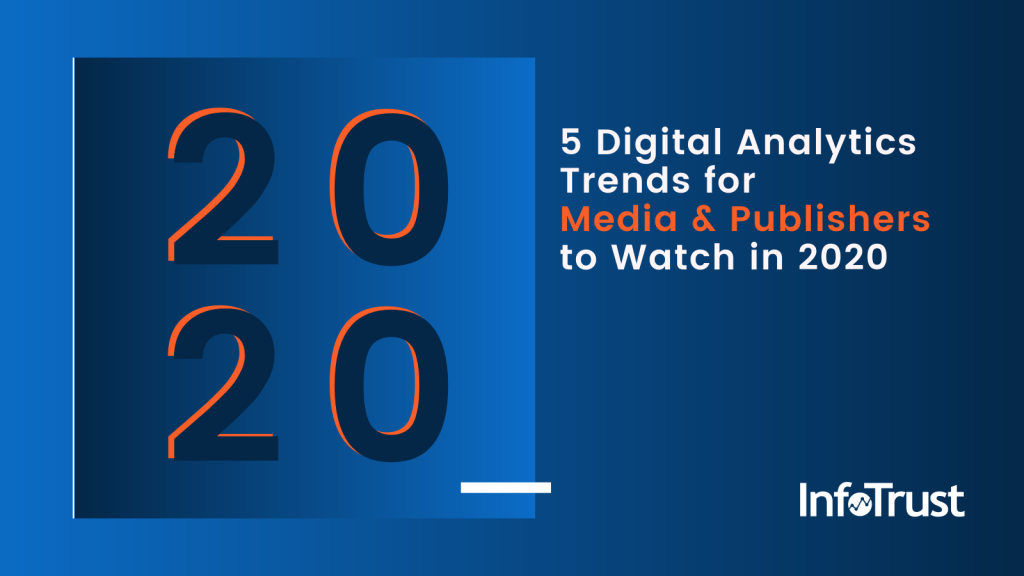Wow, 2020. Honestly, I thought we’d have flying cars and be living in the sky by now; the Jetsons had me convinced that was our future.
What’s not disappointing is how far the digital analytics industry has come and what’s in store for the new decade. We’ve seen some exciting news and trends over the last few years, and the 20s will continue to reveal more.
For companies in the news, media, and publishing industries, there are some digital analytics trends to follow—and some not-so-exciting trends to be aware of.
1. The ‘Browsers vs. Ad Industry’ Wars Will Continue
Doesn’t everyone love companies making decisions for them?
Companies like Mozilla and Apple (makers of the Firefox and Safari browsers, respectively) have taken a hard stance on user privacy and security in the last few years within their internet browsers. This, in theory, sounds great and is hard to disagree with. Who doesn’t think users’ online data should be safe and secure?
Apple introduced Intelligent Tracking Prevention (ITP) technology and Mozilla has Enhanced Tracking Prevention (ETP) technology; both are built into their respective browsers to limit third-party (and now first-party) tracking by advertisers, website owners, and marketing and analytics platforms.
A more cynical observer may suspect an ulterior (or possibly additional) motive behind this technology: limiting advertising revenue for competitors (like Google). Google and Facebook have become an advertising duopoly, controlling the vast amount of advertising revenue. The former owns the most popular web browser in the world, Chrome, and the largest ad network; Facebook now sits alongside Google at the top of the advertising revenue market share.
Unsurprisingly, Apple’s mobile ad network that launched in the last few years is continuing to gain steam in the marketplace. So, allow me to remain skeptical that browser companies like Apple are only concerned about users’ online data privacy and security.
Regardless, these browsers are constantly updating their tracking prevention technologies to block more and more trackers and cookies. And this is where you, the publisher, get squeezed. These browsers are effectively limiting the ways you can collect data on your audiences, no matter how legitimate your intentions are.
The vast majority of publishers only want to collect non-personally identifiable information that will allow them to build more sophisticated audiences to share with advertisers. But browsers are now effectively finding new ways to block this type of activity in the (real or interest of user privacy and security. So, what’s a publisher to do besides continue to shake their fists at Apple and Mozilla?
This leads us into the second trend for 2020, the shifting of data strategy.
2. Complete Shifts in Data Strategy (First-Party Data to Third-Party Data)
With Apple and Mozilla continually looking for ways to block third-party data collection through their browsers, many organizations are responding with a complete shift in data strategy.
The days of Data Management Platforms (DMPs) that collect data on your audience using third-party trackers and cookies are limited. However heavy-handed it is, Safari and Firefox are now blocking most, if not all, third-party trackers and cookies.
For publishers especially, the reliance on third-party data sources like DMPs to collect this type of information on their audience has put them in a precarious situation. They’re (hopefully) realizing that they should’ve been focusing on first-party data collection for audience-building all along. Why let a company like Salesforce (Krux) or Oracle (BlueKai) own and sell you data on YOUR audience?
So, 2020 for publishers is a crucial year in terms of data collection and strategy. Utilizing first-party data platforms like the Google Marketing Platform and customer data platforms (CDPs) allow publishers to collect the necessary first-party audience data needed to deliver the necessary audiences to advertisers. And at the end of the day, the publisher owns their audience data, not another company.
3. Combining App and Web Data Takes a Giant Leap Forward
If you’ve been operating both websites and apps for some time, you likely are aware that the top digital analytics platforms haven’t had an easy or robust solution for tracking both app and web together. In fact, Google Analytics’ previous concept of app and web tracking did allow for you to send app and web data into the same GA property, but used completely different data models.
To fix this, Google announced App + Web properties last summer to shift both platform data collection models to an all event-based model. If you’re familiar with Firebase Analytics, it’s that same data collection model (where everything is an event).
This brings exciting possibilities for publishers in 2020. The majority of publishers we work with at InfoTrust not only have websites and mobile apps, but also over-the-top (OTT) apps on platforms like Roku, Apple TV, and Fire TV.
With Google Analytics App + Web properties (note: still in beta), publishers can send data from all of those platforms into the same property for reporting, analysis, optimization, and audience-building.
Google will be rolling out more features with App + Web properties throughout 2020 to get to some form of feature parity with Universal Analytics (the current version of Google Analytics).
From a publisher standpoint, being able to connect users easily across platforms will make their lives much easier.
4. Reliance on Artificial Intelligence and Machine Learning Will Continue to Grow
If you have been paying attention at all to the marketing and advertising industries in the last few years, you’ve probably heard “artificial intelligence” and “machine learning” somewhere around a million times.
Nearly every month we hear about a new company releasing a new marketing or advertising platform that uses AI and machine learning to solve your company’s problems and push you into the future.
Now, I can’t verify the claims from these new product companies; however, I can confirm that some very large companies are starting to build AI and machine learning into their products gradually. Google has been implementing these into its Google Analytics product as “Analytics Intelligence,” allowing users to ask questions (within the platform) about their data, and also spot data anomalies.
Salesforce has also built AI into its platforms with Salesforce Einstein to help customers make decisions faster and be more productive.
As companies become more knowledgeable about artificial intelligence and machine learning, these new technologies (or applications, however you define AI and ML) will move from platforms they buy into the actual work that’s been doing throughout the organization.
This leads me into the last key trend: data science and advanced modeling becoming more accessible to every organization.
5. Data Science and Advanced Modeling Become more Accessible to Every Organization
When InfoTrust began working with large enterprise companies, discussing data science and advanced modeling was almost taboo. Many organizations saw this area of advanced analytics as a pipe dream that was too costly, complex, and unproven.
And some of those arguments a few years ago would have been partially correct. But today, with the accessibility of cheap cloud storage and computing, these advanced analytics are no longer a pipe dream. They are very real and very accessible to even the smallest organizations.
Today, Google Cloud Platform, Amazon AWS, and other online warehousing platforms are making it very cheap to implement machine learning directly in the cloud on serverless computers. This type of scalability has drastically decreased costs, which were large barriers even five years ago.
But in the last two years, we’ve worked with many organizations to build advanced models for a number of use cases, from predicting eCommerce revenue during Black Friday/Cyber Monday to calculating Customer Lifetime Value (CLV; see the video below for a quick intro) to use in campaigns to lower the return on advertising spend. Cloud computing is a beautiful thing.
We’re excited to bring data science opportunities to more of our clients in 2020 to reduce their advertising waste, predict their customers’ future behavior, and more accurately value those customers.
Questions About an Analytics Trend?
The InfoTrust team is interested in seeing how these trends pan out this year, and I look forward to helping our news, media, and publishing clients stay on the cutting edge of the digital analytics industry.
If you have a question about any of the trends mentioned above, or simply about digital analytics best practices and strategies for publishers, please don’t hesitate to reach out.


